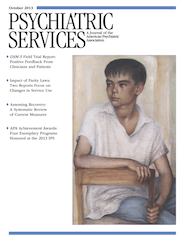Axis V: Essential Supplement to the DSM-5
To the Editor: DSM-5 (1) eliminates axis V, which we think is a mistake. Despite the inclusion of about 50 measures of impairment severity, none is able to generate standardized global scores both within and across diagnoses. We recommend that clinicians and administrators continue to use axis V and related measures as a supplement to the DSM-5.
The genius of axis V has been its focus on global measures of functioning within diagnoses and across all diagnoses to assess outcome of treatment. This is just as useful today as it was when it was introduced in the DSM-III. Currently, several instruments measure global functioning using axis V’s standard rating continuum. These instruments can easily work with the DSM-5. In addition to axis V's Global Assessment of Functioning (GAF) (2), these instruments include the Kennedy Axis V (K axis) (3), the Social and Occupational Functioning Assessment Scale (4), and the Mental Illness, Research, Education and Clinical Center GAF (5). Each of these instruments has similar anchor points and rating instructions and uses the scoring continuum established worldwide by axis V.
In the DSM-5, measurement of functioning and severity of illness is addressed by the inclusion of about 50 measures, placed throughout the book. Most of these measures are tailored to individual diagnoses to “specify current severity” and are often located within the diagnostic criteria (1). Unlike axis V, none of these instruments generate global scores that allow standardized comparisons across the entire diagnostic spectrum.
Of the 50 measures, the measurements that appear closest to axis V are the World Health Organization Disability Assessment Schedule, a global measure of functioning, and the “cross-cutting symptom measure,” which is intended to make measurements across diagnoses and “over time to track the patient's symptoms status and response to treatment” (1). This symptom measure, however, does not generate a global score. Global measurement has been the main role of axis V, and in our opinion it should continue to be used as a supplement to the DSM-5′s new diagnostic system.
In summary, we assert that the supplemental use of axis V and related instruments makes sense for a number of reasons. They preserve axis V's standardized scoring continuum as a generic measure for severity of illness and level of functioning, both within a diagnosis and across diagnoses. They can give an overall image of illness severity with a single number. They are easy to use, and ratings can be done very quickly. With good training, their reliability can be good (2). They have been widely used in research, and thousands of publications have axis V values. Finally, the information about axis V and related instruments in professional publications can be used to improve our ability to make global measures and track outcome (2).
1 Diagnostic and Statistical Manual of Mental Disorders, 5th edition. Arlington, Va, American Psychiatric Publishing, 2013Google Scholar
2 : Global Assessment of Functioning (GAF): properties and frontier of current knowledge. Annals of General Psychiatry 9:20, 2010Crossref, Medline, Google Scholar
3 : Mastering the Kennedy Axis V: A New Psychiatric Assessment of Patient Functioning. Washington, DC, American Psychiatric Publishing, 2003Google Scholar
4 : Revising axis V for DSM-IV: a review of measures of social functioning. American Journal of Psychiatry 149:1148–1156, 1992Link, Google Scholar
5 : The MIRECC version of the Global Assessment of Functioning scale: reliability and validity. Psychiatric Services 58:529–535, 2007Link, Google Scholar



